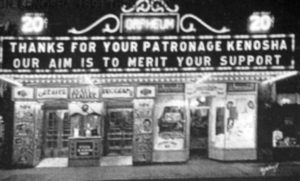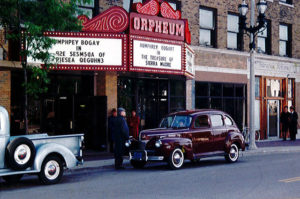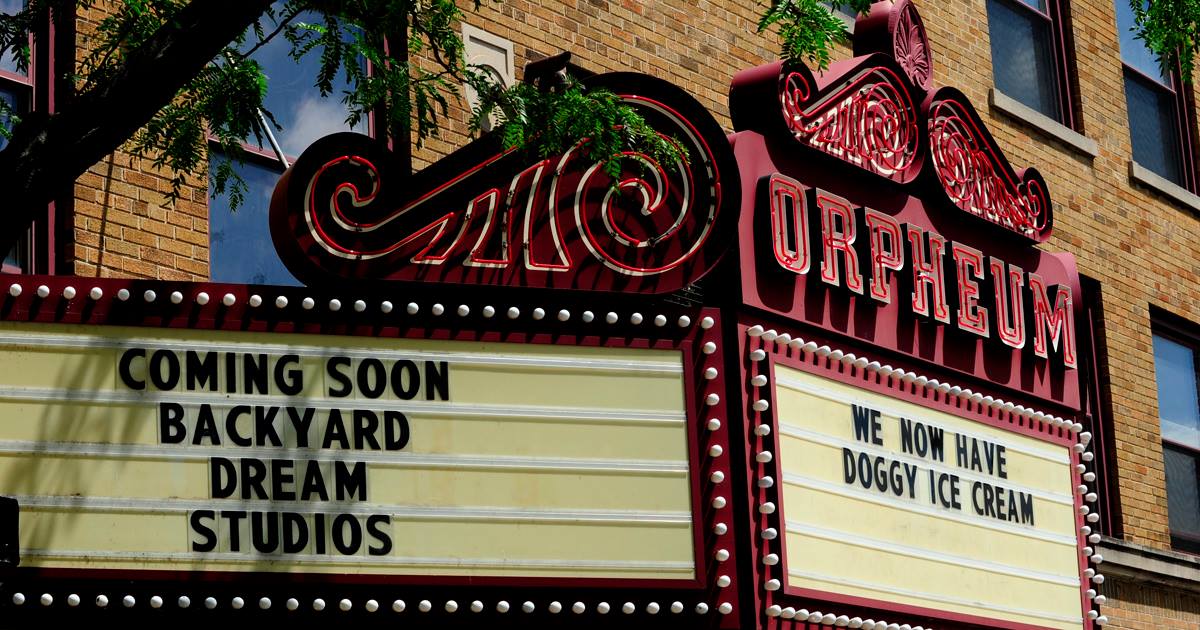Theater History
In the 1920s, the showing of movies became more elaborate than the nickelodeon or opera house productions. The movies were longer, and often accompanied by vaudeville acts. These movie palaces featured elaborately, and often exotically, decorated interiors with large auditoriums, big stages, and fine organs and organists who provided musical accompaniment to the silent pictures. The Orpheum, like many movie palaces, was hidden behind a very simple commercial building.

One of the original pictures of the Kenosha Orpheum
In 1927, the Kenosha Theatre was completed, becoming the second movie palace downtown. In that same year, the old Rhode Opera House was replaced with the Gateway Theatre, making it the third movie palace in Kenosha’s downtown. The Orpheum Theatre operated into the 1970s, but closed when multiscreen suburban theatres began to take business away from large, downtown theatres. The building retained its commercial use until the 1980s when the building stood vacant for a number of years. The Orpheum Theatre Building is a good example of modern 1920s commercial building. Many movie palaces were constructed within plain commercial buildings, often presenting a very small facade at the street level, with the bulk of the building hidden behind the commercial streetscape. The Orpheum is typical in that the bulk of the theatre is hidden at the back, but it also features a large commercial front of offices and stores at the street level. Martin Tullgren was a Swedish immigrant who established an architectural practice in Chicago in 1881. In 1902 the firm moved to Milwaukee. Martin’s sons Minard and Herbert trained in their father’s firm and the sons became partners in 1909. Martin Tullgren & Sons specialized in large projects like hotels, commercial buildings and apartment houses. In 1922 Martin died, and his sons continued the firm until 1928, when Minard died. Herbert Tullgren continued to practice under the firm name until 1936, when he changed it to Herbert Tullgren, Architect. In the 1930s, Herbert Tullgren was one of the foremost architects practicing in the progressive Art Deco and Art Moderne styles in Milwaukee, and three of his apartment designs made important contributions to the development of twentieth-century apartment-house construction.
 The Orpheum Theatre Building is typical of the modern buildings designed by Martin Tullgren & Sons. Because the building was constructed in 1922, the year Martin died, it is probably more the work of his sons Minard and Herbert than of himself The interior of the Orpheum was designed in the French Renaissance style and the decorative details included rich rugs, gold pendants, mirrored lights, polychromed baskets, silk-beaded upholstery, velvet drapes and curtains, and silk wallpaper in red, blue, orange and gold tones. The result was a theatre that dramatically contrasted with the plain commercial exterior of the building. Because the Orpheum Theatre is a fine example of a 1920s movie palace designed by a master architectural firm, it is a significant landmark in downtown Kenosha. The Orpheum Theatre is also significant because the movies have had a profound effect on American culture, and going to the movies was an important ritual in American towns and cities that still exists today.
The Orpheum Theatre Building is typical of the modern buildings designed by Martin Tullgren & Sons. Because the building was constructed in 1922, the year Martin died, it is probably more the work of his sons Minard and Herbert than of himself The interior of the Orpheum was designed in the French Renaissance style and the decorative details included rich rugs, gold pendants, mirrored lights, polychromed baskets, silk-beaded upholstery, velvet drapes and curtains, and silk wallpaper in red, blue, orange and gold tones. The result was a theatre that dramatically contrasted with the plain commercial exterior of the building. Because the Orpheum Theatre is a fine example of a 1920s movie palace designed by a master architectural firm, it is a significant landmark in downtown Kenosha. The Orpheum Theatre is also significant because the movies have had a profound effect on American culture, and going to the movies was an important ritual in American towns and cities that still exists today.
 This form of mass popular culture was particularly important in the City, making Kenosha movie palaces historically significant and important historical landmarks. The theater was opened again in 1994 as a 4-screen discount movie theater with stadium seating. Tickets prices were $2.00 and Tuesdays were $1.00. It was closed again in 2000 sold in 2001. (From City documents.)
This form of mass popular culture was particularly important in the City, making Kenosha movie palaces historically significant and important historical landmarks. The theater was opened again in 1994 as a 4-screen discount movie theater with stadium seating. Tickets prices were $2.00 and Tuesdays were $1.00. It was closed again in 2000 sold in 2001. (From City documents.)





